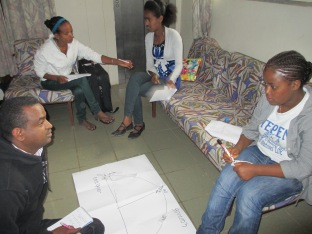In the early 1970s, Americans became preoccupied with the plights of homeless and runaway youth. Congress, in response, held hearings on the issue starting in January 1972, which culminated two years later in a major piece of legislation. 1974’s Runaway Youth Act has since gone through many periodic reauthorizations and renamings before arriving at the most recent incarnation, the
2008 Runaway and Homeless Youth Act (RHYA, known officially as the Reconnecting Homeless Youth Act).
Since its inception, the RHYA has served as a major source of funding for public and private nonprofit organizations that serve youth who have become disconnected from their homes and families. Among its many provisions, the law establishes three main federal programs:
1. National Communication System: The RHYA has provided the financial backing for the
National Runaway Safeline (1-800-RUNAWAY), a 24-hour crisis hotline. The hotline addresses a wide spectrum of youth, from people on the streets to those in precarious living situations, by directing callers to local service providers providing guidance to youth who may just need someone to talk to.
2. Basic Center Grant Program: Under the RHYA, the Department of Health and Human Services is authorized to provide grants to local nonprofit organizations and public entities as an alternative to involving youth in the child welfare or juvenile justice systems. A minimum of $200,000 is allotted annually to each state to be distributed in grants. Grant recipients must provide short term shelter and counseling services, and they may also offer substance abuse education and STI testing to runaway and homeless youth.
3. Transitional Living Grant Program: For the many youth who experience abuse, neglect, or severe conflict at home, emergency shelters operating under the Basic Center Grant Program do not provide necessary, long-term assistance. To address these youth, the RHYA calls for grants allocated to transitional living programs, that can provide homeless and runaway youth with shelter for up to 18 months while aiding them in becoming self sufficient.
There are at least 1.6 million runaway and homeless youth in the U.S. alone
To date, the Runaway and Homeless Youth Act has been largely successful in assisting at-risk or in-need youth from life on the streets, and the
risks of trafficking that accompany homelessness. The National Runaway Safeline alone fields over 100,000 calls a year, while countless youth have benefited from the Basic Center and Transitional Living Programs. However, as the RHYA returns to the floor of Congress for reauthorization at the end of September, many are looking to fill one egregious gap in the legislation: a lack of protections for LGBT homeless and runaway youth.
Since the RHYA was initially passed in 1974, the LGBT community has gone through substantial changes. A far cry from the days of “We’re Here, We’re Queer” chants, LGBT causes have attracted more mainstream attention and popular support. Research also shows that people have been steadily identifying at younger and younger ages; whereas people used to come out well into adulthood, the average age at which people first self-identify as lesbian, bisexual, gay, transgender, or queer is now 16. As a result, more youth are faced with negative family reactions and bullying at school, leading to a large population of LGBT youth who are kicked out or decide to leave pernicious home environments. Currently, the best estimates state that between 20 and 40 % of all homeless youth identify as LGBT, depending on the area.
Unfortunately, the RHYA has failed to keep up with the times, and despite several reauthorizations, it still lacks any provisions for dealing with the substantial LGBT homeless and runaway youth population.
Two Wisconsin Congresspeople, Representatives Gwen Moore and Mark Pocan, however, have recently sought to amend the RHYA.
Representatives Gwen Moore (WI-4) and Mark Pocan (WI-2) proposed the new, inclusive legislation
The legislative duo, introduced a new bill on August 1, known as the Runaway and Homeless Youth Inclusion Act (
RHYIA), that would add specific provisions for LGBT youth to the extant RHYA. Highlights of Reps. Moore and Pocan’s proposed legislation include:
· Language specific to LGBT youth added to the bill: The RHYIA would state that grant programs should include outreach programs to “cultural minorities and persons who are in a minority category related to sexual orientation or gender identity or expression.” (emphasis added)
· Mandates that service providers offer “culturally competent” services and that such services be made available for all youth: Frequent complaints from LGBT homeless youth mention that service providers lack knowledge of LGBT issues, preventing these youth from accessing needed services and leading many to return to the streets
· Programs specific to LGBT homeless and runaway youth, such as family intervention and reunification services or resources for family members struggling to accept a youth’s sexual orientation or gender identity or expression
· A nondiscrimination section stating that no youth can be denied services on the basis of sexual orientation or gender identity or expression, among other factors
In the coming months, as Congress sets out to debate the RHYIA, IOFA is also working on addressing under-served communities, including LGBT youth. The nascent LGBTQ subcommittee of the Cook County Human Trafficking Task Force will convene community members, service agencies, and young people to develop better means of serving LGBT trafficking victims. A newly forming Labor Trafficking subcommittee will also bring attention to a side of human trafficking that is often overlooked.
Matt Kellner,
Project Development Intern






